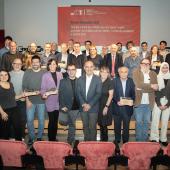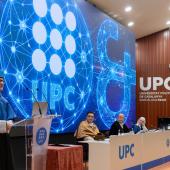Kingdom Tower: The structural system and how it was developed
There is a relatively small menu of structural systems to choose from in selecting an appropriate solution for a supertall building, and an even smaller set for a very slender 1-km-tall tower. Further, the locate at which the tower is to be built, the expertise of available contractors, and the predominance of local systems and construction materials further tend to limit the system choices.
The architectural constraints, most particularly the building program and use, are primary drivers for any structural system selection. During the early stages of the competition phase, it became clear that as matter of risk management for this first-of-its-kind tower, the structural system should fundamentally build on the success of the recently completed Burj Khalifa, but refining and improving on those elements of the system proved to be more problematical during the construction and realization of the Dubai tower.
In the most basic engineering terms, the structure for Kingdom Tower utilizes a cast-in-place reinforced concrete bearing wall system. Although the scale of the structure is without precedent, the concept and antecedents for the system can be traced as far back as the CN Tower in Toronto, Canada, completed in 1976, and even earlier.
Figure 8.3 presents a comparison of primary structural wall layouts at the base for the CN Tower, Burj Khalifa, and Kingdom Tower. The similarities are clear for each of these three-legged structures. The entire tower from is populated with a series of intersecting walls radiating from a central closed prismatic tube.
The wall elements form a series of closed cells that are extended to the utmost extremities of the tower, thereby creating the requisite gravity, lateral, and torsional load resistance and stiffness. The system is uniquely suited for residential (hotel, condominium, apartment) use because it naturally creates a distinct set of discrete spaces bounded by structural walls without particularly long floor spans. Given the overwhelming preference for reinforced concrete construction in the Kingdom, the bearing wall system of reinforced concrete was quickly selected and then refined by the design team during the competition phase. The fundamentals of the system remained consistent from the earliest days of the competition to the completion of design documents.
Structural system synopsis
All gravity and lateral wind/seismic loads are resisted by the system of cast-in-place reinforced high-strength concrete walls, which are themselves interconnected by coupling, or link, beams, which allow access into the various zones of the floor plate. The most heavily stressed and prominent walls are those at the ends of the three wings located adjacent tot he fire escape stairs. These three end walls are the only walls in the tower that are inclined. Each end wall is inclined at a slightly different (though constant) vertical angle (3.0, 3.3 and 3.6º to the vertical, respectively) over its height and therefore reach the tower apex at different elevations, producing the distinctive design arrangement for the uppermost spire component. All other walls are vertical and simply drop off along the tower height as the end walls move closer the extent of the public corridors leading from the central core to the office and residential units in the wings. So-called fin walls, placed 9 m (30 ft) on center and perpendicular to the corridor walls, provide stiffening and stability to the system. The central triangular core wall arrangement provides significant torsional strength and stiffness to the overall structural system, while housing all of the elevator shafts from foundation to the uppermost occupied...
Unlike the majority of supertall towers designed to date, the Kingdom Tower structure has no outrigger walls of trusses, no column transfer girders, and no gravity columns disengaged from the lateral load-resisting system. All walls are structurally connected and participant in resisting lateral wind and seismic loads. Coupling beams are typically 1,5 or 1,6 m (60 or 63 in.) deep, allowing doors into the residential and office units. Wall thicknesses range from 1200 mm (47 in.) for the end walls at the base to 600 mm (24 in.) in the spire.
The tower vertical structure requires high-strength concrete but only to strengths commonly supplied to tall building projects previously in the Middle East. At the lower half of the tower, 85-Mpa (12,300-psi) minimum concrete cylinder strength is specified at 90 days; 75 and 65 Mpa (10,900 and 9400 psi) concrete strengths are specified in the upper floors and spire, respectively. The stiffness ans performance of the tower has been controlled by specifying the average modulus of elasticity (MOE) for the three grades of concrete based on the recommended MOE equations in ACI 318. Client acceptability of the high-strength concrete provided for the tower will be determined based not only the minimum strength specified but also on the average MOE. The high-strength concrete mix designs for the tower include multiple cementitious materials (portland cement, fly ash, and microsilica), next-generation superplasticizers and ice to control heat gain during concrete hydration in the thick mass concrete elements. It is anticipated that the concrete for the upper 300 m (1000 ft) of the tower will require staged pumping, whereby concrete is initially pumped to a height of 700 m (2300 ft) and a second-stage pump lifts it to the required elevation in the spire structure. Reinforcing bars are conventional 420 -and 520 Mpa- (60 and 75 ksi-) yield strength material with diameters up to 40 mm (1.6 in).
The tower floor system has been configured to allow for the utmost speed and repetition in the construction of the structure. Floors are typically framed with 250 mm thick, flat plate, reinforced-concrete, two-way spanning slabs between the walls, spaced 9 m on center, without floor beams. At some floor locations at the ends of the three wings, based on where the fin walls drop off in elevation, the span between walls is significantly greater than 9 m, requiring thicker slabs to control floor deflections. At the edges of the end walls in the corners of the three wings, cantileverd concrete beams are used to limit deflections of the floor system. At the center of the building, an arrangement of exterior cantilevered balconies on alternate floors are structured with cantilevered beams and a variety of slab edge geometries. However, the supporting walls in these areas are vertical and continuous, simplifying the construction. The general contractor for the tower intends to advance the wall construction several levels above the floor construction to maintain simplicity in the jump form system. The slabs will be connected to the walls through a system of keyways and dowel couplers at the slab / wall interface.
The subgrade conditions adjacent to the Red Sea are challenging for the support of the tower. There is no solid bedrock near the ground surface. The top 50 m of subgrade is composed of vuggy limestone formed from the remains of ancient coral reefs (coraline limestone). Below the limestone are thin layers of siltstone and gravel with a band of poor decomposed sandstone. Finally, a thick layer of hard sandstone, starting at a depth of approximately 110 m, completes the soil stratigraphy at the site. Preconstruction exploratory boreholes were drilled to a depth of up to 200 m within the tower footprint. Both down-hole and laboratory tests of soil samples were performed.
The foundation system for the tower is a combined piled raft. A matrix of 270 1,5 m and 1,8 m diameter, straight-shaft, augered reinforced concrete piles are arranged over the entire footprint of the tower. The piles are bored to a depth of 105 m in the center of the tower, varying to 45 m deep below the ends of the three wings. The entire pile foundation system is connected by a reinforced concrete raft slab varying in thickness from 5.0 m at the ends of he wings to 4,5 m in the center of the tower. The piles are constructed under polymer slurry and deliver load to the ground primarily through friction along the pile shafts. A portion of the weight of the tower is transferred directly to the ground below the underside of the raft slab.
A comprehensive battery of preconstruction full-scape pile load testing was completed to estimate the load-carrying and settlement characteristics of the system design. I was important to have not only a strong foundation system but particularly one also with one also with an appropriate stiffness because the tower superstructure load distribution is sensitive tot he foundation characteristics. It is anticipated that the overall long-term settlement of the tower will be on the order of 100 mm with differential settlements between the center and wing ends less than 20 mm.
The sky terrace outdoor platform, which is at an elevation above 600 m is a particularly challenging steel structure specifically planned as part of the observatory.
A central steel box truss is cantilevered from a steel support frame that grows outward and is encased within the main body of the tower wall structure. From this central spine-like support, transverse girders are doubly cantilevered and organized around various apertures, allowing viewing to below.
The base of the tower has separate entrances for residential, office, and hotel functions. All three faces are encompassed by a large continuous canopy element. This steel structure forms a weather barrier as well as protection from significant downdrafts due to wind near the base of the tower.
Long-term structural health monitoring
The design for Kingdom Tower includes a suggested long-term structural health monitoring program, the purpose of which is to monitor and confirm the as-built behavior of the building structure as compared to the analytical and scale model predictions. The program is designed to provide the building owner with long-term feedback as to the performance of the building structure. A variety of measuring devices at multiple locations in the building have been specified to provide real-time data for the following critical structural performance items:
-Survey and monitoring of foundation settlements
-Survey and monitoring of tower wall shortening
-Survey and monitoring of lateral deformations
-Monitoring of pile loads
-Monitoring of load transmission to raft subgrade
-Monitoring of wall stresses along the height of the tower
-Monitoring of building displacements under wind
-Monitoring of building accelerations properties of the tower
-Confirmation of actual dynamic properties of the tower
-Confirmation of actual damping levels in the tower
-Measurement of wind speed at height to correlate wind events with response
-Inspection of fracture critical structural elements
*Extracte del capítol 8 dedicat a la Kingdom Tower del llibre Tall and Supertall Buildings: Planning and Design (Ed. McGraw Hill, 2014), escrit per Robert Sinn, enginyer d'estructures a Thornton Tomasetti i Peter Weismantle, arquitecte a Adrian Smith + Gordon Gill Arquitecture









